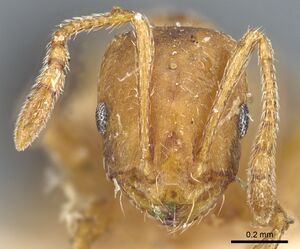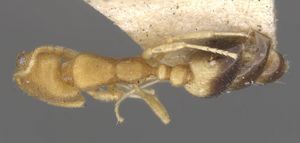Monomorium sahlbergi
| Monomorium sahlbergi | |
|---|---|

| |
| Scientific classification | |
| Kingdom: | Animalia |
| Phylum: | Arthropoda |
| Class: | Insecta |
| Order: | Hymenoptera |
| Family: | Formicidae |
| Subfamily: | Myrmicinae |
| Tribe: | Solenopsidini |
| Genus: | Monomorium |
| Species: | M. sahlbergi |
| Binomial name | |
| Monomorium sahlbergi Emery, 1898 | |
| Synonyms | |
| |
In Yemen this species was collected from a banana farm where the soil was moist and rich in decaying livestock faeces. Several pselaphine beetles were also observed in the same habitat (Sharaf et al., 2017).
| At a Glance | • Invasive |
Identification
Boer et al. (2020): Morphometrically M. sahlbergi is similar to M. pharaonis (Table 1). Compared to the workers ofM. pharaonis, 1/4 instead of 2/3 of the first gastral tergite (abdominal segment 4) is light-coloured; the structure of the frontal side of the head is strigulate rather than reticulate; the mesonotal groove is shallower; the pronotum and metanotum are higher than the propodeum in M. pharaonis as opposed to equally high in M. sahlbergi and promesonotal setae are missing on the mesosoma, in M. pharaonis two to six (Figs 1–4). Note that in Monomorium specimens the setae are quite stiff and break easily, thus reducing utility of this character in some specimens.
| M. dichroum (n = 48) | M. sahlbergi (n = 32) | M. pharaonis (n = 16) | M. pharaonis (n = 50) from Bolton, 1987 | |
|---|---|---|---|---|
| CW | 0.41–0.54 (0.44) | 0.40–0.44 (0.42) | 0.41–0.48 (0.44) | 0.40–0.48 |
| CL | 0.49–0.66 (0.54) | 0.49–0.54 (0.51) | 0.52–0.59 (0.56) | 0.52–0.60 |
| CI | 79–85 (82) | 79–85 (81) | 75–84 (80) | 73–80 |
| EYI | 19–24 (21) | 19–26 (22) | 18–20 (19) | 18–21 |
| Omm | 7–10 (9) | 7–11 (9) | 7–9 (8) | 5–7 |
| PI | 67–86 (74) | 64–73 (69) | 71–82 (78) | – |
| SI | 102–110 (103) | 103–110 (106) | 105–117 (109) | 105–117 |
Worker caste of this species can be confused with the cosmopolitan species Monomorium pharaonis (L., 1758) but it can be separated by the finely longitudinally striated head, the smooth first gastral tergite, and the dark patches in front of the eyes (Sharaf et al., 2017).
Keys including this Species
Distribution
Boer et al. (2020): All records of M. sahlbergi originate from desert-like, urban, industrial, and military areas ranging from sea level to an elevation of 1800 m. It is not clear from our research what the original geographic region of M. sahlbergi was. Based on the distribution of other species in the salomonis group, the native distribution would include specimens from the Indomalaya region (Nepal, India, Thailand). Our data came from the following main geographic regions: Palearctic (China, Israel, Netherlands (interception)), Australian (New Zealand, from likely interceptions), Nearctic (USA, in part interceptions), Neotropical (Panama, Galapagos), Afrotropical (Reunion, Madagascar) and Oceania (Hawaii).
Latitudinal Distribution Pattern
Latitudinal Range: 33° to 31.866667°.
| North Temperate |
North Subtropical |
Tropical | South Subtropical |
South Temperate |
- Source: AntMaps
Distribution based on Regional Taxon Lists
Afrotropical Region: Socotra Archipelago, Yemen.
Oriental Region: India (type locality), Nepal, Pakistan, Sri Lanka.
Palaearctic Region: China, Israel (type locality), Oman.
Distribution based on AntMaps
Distribution based on AntWeb specimens
Check data from AntWeb
Countries Occupied
| Number of countries occupied by this species based on AntWiki Regional Taxon Lists. In general, fewer countries occupied indicates a narrower range, while more countries indicates a more widespread species. |

|
Estimated Abundance
| Relative abundance based on number of AntMaps records per species (this species within the purple bar). Fewer records (to the left) indicates a less abundant/encountered species while more records (to the right) indicates more abundant/encountered species. |

|
Biology
Sharaf et al (2018) - Oman: Several workers were found in leaf litter under a date palm tree where the soil was soft and dry.
Castes
Images from AntWeb
   
| |
| Syntype of Monomorium sahlbergi. Queen (ergatoid). Specimen code casent0904577. Photographer Z. Lieberman, uploaded by California Academy of Sciences. | Owned by MSNG, Genoa, Italy. |
   
| |
| Syntype of Monomorium dichroum. Worker. Specimen code casent0902222. Photographer Will Ericson, uploaded by California Academy of Sciences. | Owned by NHMUK, London, UK. |
Nomenclature
The following information is derived from Barry Bolton's Online Catalogue of the Ants of the World.
- sahlbergi. Monomorium sahlbergi Emery, 1898c: 131, fig. (w., ergatoid q.) ISRAEL.
- Type-material: 5 syntype workers, 2 syntype ergatoid queens.
- Type-locality: Israel: Jericho (J. Sahlberg).
- Type-depository: MSNG.
- Status as species: Emery, 1908h: 684; Emery, 1922e: 174; Menozzi, 1933b: 65 (in key); Ettershank, 1966: 92; Kugler, J. 1988: 257; Bolton, 1995b: 266; Vonshak, et al. 2009: 43; Borowiec, L. 2014: 125; Boer, et al. 2020: 93.
- Senior synonym of dichroum: Boer, et al. 2020: 93.
- Distribution: China, India, Israel, Oman, Sri Lanka, Yemen.
- dichroum. Monomorium dichroum Forel, 1902c: 212 (w.q.) INDIA (West Bengal, Karnataka, Maharashtra, Tamil Nadu).
- Type-material: syntype workers (number not stated).
- Type-localities: India: Bombay (Wroughton), Belgaum (Wroughton), Poona (Wroughton), Coonoor (Daly).
- Type-depository: MHNG.
- Imai, et al. 1984: 7 (k.).
- Status as species: Forel, 1903a: 688; Bingham, 1903: 202; Forel, 1908a: 3; Forel, 1911i: 221; Forel, 1918a: 721; Emery, 1922e: 173; Chapman & Capco, 1951: 164; Ettershank, 1966: 88; Bolton, 1995b: 261; Tiwari, 1999: 55; Guénard & Dunn, 2012: 45; Bharti, Guénard, et al. 2016: 39; Sharaf, Fisher, et al. 2017: 23; Sharaf, Fisher, et al. 2018: 25; Dias, R.K.S. et al. 2020: 77 (error).
- Junior synonym of sahlbergi: Boer, et al. 2020: 93.
Description
Worker
Bingham (1903)(described as M. dichroum): Remarkably like M. pharaonis, Linn., in colour, but is a shorter, move robustly built insect. Kedclish yellow, the abdomen black, with the base above a clearer brighter reddish yellow than the colour of the thorax; head, thorax, pedicel and base of abdomen more or less densely minutely rugulose and opaque, the sculpture on the base of the abdomen lighter; pilosity nearly wanting, as in M. pharaonis; pubescence very thin and light. Head not so long as in the above species, but broader, the occiput slightly emarginate; mandibles and clypeus similar; antennae shorter, the scape falling distinctly short of the; top of the head: eyes placed a little more anteriorly than in M. pharaonis. Thorax somewhat depressed, broad; the meso-metanotal suture-e only moderately impressed; the metanotum rather short and abruptly truncate. Pedicel: 1st node squamiform, with a long petiole anteriorly; 2nd node globose, broader than long ; abdomen oval.
Length: 2 - 2.5 mm
Queen
Apparently both winged and ergatoid. The former "of a reddish yellow with some brown marks; abdomen smooth." The latter "entirely brown with 3 ocelli"; the abdomen reticulate, the metanotum grooved but Without teeth; the rest resembling the queen of M. schurri.
Length: 3 - 4 mm
Please refer to Boer et al. (2020) for further details.
Karyotype
- 2n = 16 (India) (Imai et al., 1984).
References
- Boer, P., Loss, A.C., Bakker, F., Beentjes, K., Fisher, B.L. 2020. Monomorium sahlbergi Emery, 1898 (Formicidae, Hymenoptera): a cryptic globally introduced species. ZooKeys 979, 87–97 (doi:10.3897/ZOOKEYS.979.55342).
- Borowiec, L. 2014. Catalogue of ants of Europe, the Mediterranean Basin and adjacent regions (Hymenoptera: Formicidae). Genus (Wroclaw) 25(1-2): 1-340.
- Emery, C. 1898c. Beiträge zur Kenntniss der palaearktischen Ameisen. Öfvers. Fin. Vetensk.-Soc. Förh. 20: 124-151 (page 131, fig. worker, ergatoid queen described)
- Sharaf, M. R., Wetterer, J. K., Mohamed, A. A., Aldawood, A. S. 2022. Faunal composition, diversity, and distribution of ants (Hymenoptera: Formicidae) of Dhofar Governorate, Oman, with updated list of the Omani species and remarks on zoogeography. European Journal of Taxonomy 838: 1-106 (doi:10.5852/ejt.2022.838.1925).*Subedi, I.P., Budha, P.B., Bharti, H., Alonso, L. 2020. An updated checklist of Nepalese ants (Hymenoptera, Formicidae). ZooKeys 1006, 99–136 (doi:10.3897/zookeys.1006.58808).
References based on Global Ant Biodiversity Informatics
- Borowiec L. 2014. Catalogue of ants of Europe, the Mediterranean Basin and adjacent regions (Hymenoptera: Formicidae). Genus (Wroclaw) 25(1-2): 1-340.
- Emery, C. "Beiträge zur Kenntniss der palaearktischen Ameisen." Öfversigt af Finska Vetenskaps-Societetens Förhandlingar (Helsinki) 20 (1898): 124-151.
- Emery, C. "Beiträge zur Monographie der Formiciden des paläarktischen Faunengebietes. (Hym.) Teil V. Monomorium." Deutsche Entomologische Zeitschrift 1908 (1908): 663-686.
- Ettershank G. 1966. A generic revision of the world Myrmicinae related to Solenopsis and Pheidologeton (Hymenoptera: Formicidae). Aust. J. Zool. 14: 73-171.
- Forel A. 1902. Myrmicinae nouveaux de l'Inde et de Ceylan. Rev. Suisse Zool. 10: 165-249.
- Forel A. 1903. Les Formicides de l'Empire des Indes et de Ceylan. Part X. J. Bombay Nat. Hist. Soc. 14: 679-715.
- Forel A. 1911. Ameisen aus Ceylon, gesammelt von Prof. K. Escherich (einige von Prof. E. Bugnion). Pp. 215-228 in: Escherich, K. Termitenleben auf Ceylon. Jena: Gustav Fischer, xxxii + 262 pp.
- Forel, A. 1908. Fourmis de Ceylan et d'Égypte récoltées par le Prof. E. Bugnion. Lasius carniolicus. Fourmis de Kerguelen. Pseudandrie? Strongylognathus testaceus. Bull. Soc. Vaudoise Sci. Nat. 44: 1-22
- Martinez J. J. 2008. Firebreaks in planted pine forests in Israel: patches for Mediterranean Bata ants. Vie et Milieu 58(3/4): 233-236.
- Narendra A., H. Gibb, and T. M. Ali. 2011. Structure of ant assemblages in Western Ghats, India: role of habitat, disturbance and introduced species. Insect Conservation and diversity 4(2): 132-141.
- Rajan P. D., M. Zacharias, and T. M. Mustak Ali. 2006. Insecta: Hymenoptera: Formicidae. Fauna of Biligiri Rangaswamy Temple Wildlife Sanctuary (Karnataka). Conservation Area Series, Zool. Surv. India.i-iv,27: 153-188.
- Ramachandra T. V., M. D. Subash Chandran, N. V. Joshi, A. Narendra, and T. M. Ali. 2012. Ant species composition and diversity in the Sharavathi Rivers basin, central Western Ghats. Sahyadri Conservation Series 3, ENVIS Technical Report 20. 51 pages.
- Vonshak M., and A. Ionescu-Hirsch. 2009. A checklist of the ants of Israel (Hymenoptera: Formicidae). Israel Journal of Entomology 39: 33-55.

